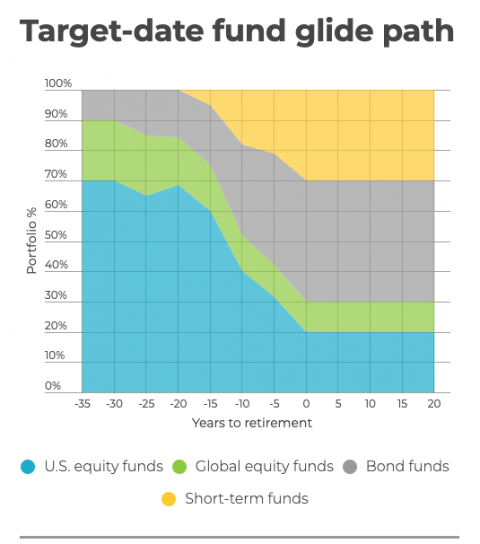5 Low-Cost Target-Date Funds for 2024

Many or all of the products featured here are from our partners who compensate us. This influences which products we write about and where and how the product appears on a page. However, this does not influence our evaluations. Our opinions are our own. Here is a list of our partners and here's how we make money.
The investing information provided on this page is for educational purposes only. NerdWallet, Inc. does not offer advisory or brokerage services, nor does it recommend or advise investors to buy or sell particular stocks, securities or other investments.
Target-date funds are a "set it and forget it" retirement savings option that removes two headaches for investors: deciding on a mix of assets and rebalancing those investments over time.
What is a target-date fund?
Target-date funds, also known as life-cycle funds or target-retirement funds — aim to continually strike the right balance between the risk necessary to build wealth and safer bets to protect a growing nest egg. The fund automatically rebalances your portfolio with the right mix of stocks, bonds and money market accounts as you age. These are mutual funds that purchase from other mutual funds (known in the business as a “fund of funds”) to build a diverse portfolio. While you set and forget, the fund updates your asset allocation through the years.
Early in your working life, a target-date fund generally is set for growth by having a much larger slice of your portfolio in stocks rather than fixed-income investments like bonds, which are safer but provide smaller returns. As your retirement year approaches, the fund gradually shifts toward more bonds, money market accounts and other lower-risk investments.
Your retirement year is the "target date" of most of these funds, and the funds are conveniently named to correspond with your planned retirement year. Say you are 40 years old and plan to work until you are 65. Most target-date funds are named in five-year increments, so you would choose the provider with a fund named with the year nearest your planned retirement date.
NerdWallet rating 4.9 /5 | NerdWallet rating 5.0 /5 | NerdWallet rating 4.1 /5 |
Fees $0 per online equity trade | Fees $0 per trade | Fees $0 per trade |
Account minimum $0 | Account minimum $0 | Account minimum $0 |
Promotion None no promotion available at this time | Promotion None no promotion available at this time | Promotion Get up to $700 when you open and fund a J.P. Morgan Self-Directed Investing account with qualifying new money. |
Top target-date funds with low costs for 2024
Here are some popular target-date funds designed for investors planning to retire in 2045. We selected funds open to new investors with low costs (no sales commissions, and expense ratios of 1% or less) and minimum investments of $2,500 or less.
Fund | Symbol | Expense Ratio |
|---|---|---|
Vanguard Target Retirement 2045 Fund Investor Shares | VTIVX | 0.08% |
Fidelity Freedom Index 2045 Fund Investor Class | FIOFX | 0.12% |
Lifecycle Index 2045 Fund Premier Class | TLMPX | 0.25% |
American Funds 2045 Target Date Retirement Fund Class R-5 | REHTX | 0.42% |
T. Rowe Price Retirement 2045 Fund | TRRKX | 0.62% |
This data is current as of April 2, 2024. Data is for informational purposes only.
The chief appeal of target-date funds is their simplicity. “If you think about putting together funds as you would cook good a meal, asset allocation is the choice of ingredients that goes in,” says Laura Scharr, principal at Laura Scharr Coaching, a financial coaching firm in Columbia, South Carolina. With target-date funds, “it’s an instant meal — they’ve put all the ingredients together for you.”
Why invest in target-date funds
Their convenience is a big reason many Americans already own target-date funds, although many may not know it. Target-date funds are the default plan of choice for many providers of employer-backed retirement plans such as 401(k) accounts.
Another advantage of target-date funds is that they keep investors from being their own worst enemy by being too reactive to the market's twists and turns, which often results in buying high and selling low.
“In 2008, most 401(k) holders stuck with their plan, while in the parallel world of do-it-yourself investors, emotions got the best of them and they pulled out,” says financial advisor Jonathan Broadbent, founding partner at Plan Partners in Beachwood, Ohio. Those who exited eroded their ability to benefit from the long bull market that followed the crisis, Broadbent says.
» Learn more: How to invest in mutual funds.
How target-date funds work
Target-date funds may be a quick-meal approach to portfolio management, but recipes and ingredients can vary widely across your menu of offerings.
One feature of all target-date funds is their “glide path,” or how the funds descend from a high ratio of riskier equity funds toward safer investments like bonds, and then land, freezing your asset allocation at its most conservative mix to protect your nest egg.

For example, a fund may begin with a heavy mix of domestic and global equity funds making up 90% of the total investment. But by retirement, equity funds make up only 30% of the total investment, while fixed-income investments such as bonds and short-term funds make up the rest. Providers will offer a more sophisticated range of strategies and mixes in gliding toward your final asset allocation.
An important question to ask when choosing among target-date funds: Is this a “to” fund, in which the glide path freezes your asset allocation the year you plan to retire, or a “through” fund that continues the glide path for 10 years or more past retirement before freezing your asset allocation? The philosophy of “through” funds is that life (hopefully) doesn’t stop at retirement. You still may have 20 years or more of living expenses, and the glide path toward safer investments should reflect that.
Different “through” target-date funds may extend the glide path 10, 15 or 20 years past retirement, so choose one that’s right for your retirement goals.
How to invest in target-date funds
There are three ways to invest in a target-date fund. As mentioned above, target-date funds are a common preset choice for a 401(k). If you have a 401(k) and never changed what's in it, there’s a good chance you already have a target-date fund.
You also can open a brokerage account with a fund manager or online broker to shop for target-date funds. Or you can purchase one directly from a fund provider like Vanguard, Fidelity or T. Rowe Price, but there your choices may be more limited.
The fund may require a minimum initial investment that can range from $500 to $3,000 or more. But some funds will waive the investment minimum if you make monthly deposits to your account.
» Wondering which broker to use? Check out our roundup of the best brokers for mutual funds.
Other important things to consider:
How much does it cost?
Beyond the initial deposit, also consider ongoing fees you’ll pay. The cost of a mutual fund is known as its expense ratio, an annual fee expressed as a percentage of your investment — or, as the name suggests, the ratio of your investment that goes toward the fund’s expenses. The higher the fees, the more costs can erode total returns.
The average target-date fund had an expense ratio of 0.52% in 2020, according to research from Morningstar. But these fees can range from as low as 0.1% to more than 1.5%, so there’s room to shop around. The difference in price often revolves around whether the fund leans on cheaper passive investing strategies or more costly actively managed accounts.
Know what’s inside
Besides comparing expenses, also compare funds' investing philosophies. Understand that two identically named 2050 funds could have very different strategies for dialing your investments down from a heavier mix of equities toward bonds as you age. The asset-allocation strategy may be too conservative — or not conservative enough — depending on your appetite for risk. (This is also a good reason to crack open your 401(k) and see if there are other target-date funds on offer that are a better fit than the default choice.)
» Active vs. passive investing: What’s the difference?

Don't just forget about it
While the set-and-forget nature of target-date funds is a key feature, experts advise looking at your fund's performance once a year to ensure it still works for you. Also, look at other investments you hold. How do those assets and your target-date fund fit together? If you don’t know, you run the risk of double-dipping on asset classes, even buying the same fund twice, experts warn. An annual checkup of your total portfolio could spot such problems.
Remember, the growing popularity of target-date funds doesn’t mean they’re foolproof: All investments carry risks, and target-date funds are no exception. But for many investors, the one-stop convenience makes target-date funds the right choice.
On a similar note...






